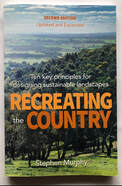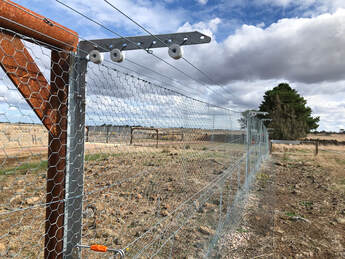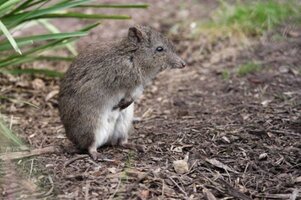Recreating the Country blog |
 This is an abridged extract from chapter 8 of my recently published book 'Recreating the Country. Ten key principles for the design of sustainable landscapes.' Ch. 8. 'Restoring natural landscapes,' takes a practical look at the different revegetation methods and reviews rewilding initiatives in Australia and worldwide. (Some of the original text and images from the book have been changed for this article). To read more about Recreating the Country, please click here  Yellow Gum, Eucalyptus leucoxylon, naturally regenerating along a roadside near Bannockburn, Victoria Yellow Gum, Eucalyptus leucoxylon, naturally regenerating along a roadside near Bannockburn, Victoria Rewilding in Australia Rewilding and natural regeneration both aim to restore local ecologies using nature-driven processes. In natural regeneration, creating the right conditions for plants to spread from roadsides and reserves is the priority. It is then hoped that wildlife will return when the plants grow and their natural habitat is re-established – ‘plant it and they will come.’ Rewilding emphasises returning animals, native to an area, in the hope that their digging, grazing and browsing will stimulate the native plants to re-emerge. Therefore rewilding has similar aims to natural regeneration, although it brings an awareness of the vital roles that wildlife play in a recovering ecology.  Cat and fox proof fencing at Tiverton Farm, Dundonald, on the Victorian Volcanic plains. This fence cost $50/m to install in 2018 Cat and fox proof fencing at Tiverton Farm, Dundonald, on the Victorian Volcanic plains. This fence cost $50/m to install in 2018 A critical first step in rewilding (& natural regeneration) is removing introduced grazing animals like sheep, cattle, horses, pigs and rabbits, as well as changing farming practices that prevent native plants from re-establishing. With rewilding in Australia, all feral predators like foxes and cats need to be excluded, so the small native grazing and digging animals can survive and support natural recovery processes. Tiverton Farm near Dundonald, Victoria, has approx. 1,000ha of predator free fencing and is home to a wild population of threatened Eastern Barred Bandicoots, released in October 2020. Eastern Quolls are soon to be released which will be the first time they will be seen in the region for over 70 years. ‘Rewilding is giving nature the space and time – critically – to dictate its own ecological trajectorie. (Nogrady, 2023) In Australia, rewilding requires more active management, because unlike the UK, Europe and USA, our ecologies have been significantly influenced by humans for more than 60,000 years. Across and throughout the continent, First Australians used sophisticated burning and soil disturbance strategies over millennia, which shaped the type and location of native vegetation and the wildlife it supported. ‘Australia’s landscapes are as much cultural as natural. People were everywhere, affecting everything, across the length and breadth of the continent over an unimaginable timescale.' Wettenhall, 2018  Weed management by Indigenous Rangers at the Tarlka Matuwa Piarku Aboriginal Corporation's reserve. Photo, Tarilka Matuwa Piarku website. Weed management by Indigenous Rangers at the Tarlka Matuwa Piarku Aboriginal Corporation's reserve. Photo, Tarilka Matuwa Piarku website. Today, much of the rewilding happening across Australia occurs under the watchful eye of Indigenous rangers. In one instance, in the northern desert regions, they are working across a vast Native Title protected area of 570,000ha, which is managed by the Tarlka Matuwa Piarku Aboriginal Corporation. Through burning and feral animal control, native wildlife and the supporting vegetation is recovering. Rewilding is also happening in fenced-off areas across Australia, where the exclusion of feral predators has allowed the reintroduction of endangered wildlife populations. The most extensive fenced sanctuaries are owned by the non-profit environment organisation, the Australian Wildlife Conservancy (AWC), which is currently managing over 30 sites across 12.9 million hectares, some in partnership with Indigenous owners and others, as a partner with the NSW National Parks and Wildlife Service. A global leader in science-informed, breeding and conservation of Australia’s endangered wildlife, the AWC employs over 80 ecologists and delivers the nation’s largest biodiversity monitoring program. In Victoria, the Odonata Foundation manages six sanctuaries, including the state’s largest fenced sanctuary at Mt Rothwell, near the You Yangs, Geelong, which has successfully bred extremely rare Eastern Barred Bandicoots and Southern Brush Tail Rock Wallabies. Of particular interest are the small foraging and digging marsupials like bandicoots, bilbies, bettongs and potoroos. These animals play an essential role in our wild landscapes by disturbing the soil. This both stimulates native seed germination and spreads symbiotic fungi spores. These fungi are the indispensable partners needed by most Australian plants. Regrettably, these ‘bite-sized’ marsupials are prey for cats and foxes, though importantly they are not the usual prey of the Dingo, which prefers larger herbivores. To be entertained while you understand more about the importance of these small marsupials, click here  Dingo reintroduction trials in National Parks are long overdue. Dingo reintroduction trials in National Parks are long overdue. Apex predators and removing feral animals Dingoes have historically played a vital role in Australian ecosystems by keeping kangaroos and emus populations under control. They can also target feral goats, reducing their destructive impact on native vegetation. By controlling the numbers of herbivores, Dingoes can engineer the recovery of native plants and in the dryer parts of Australia, their effect on plant life may even affect the height and shape of sand dunes. Dingoes also limit the effect of feral cats and foxes, either by eating them or forcing them to move out of an area. ‘Dingoes can reduce the abundance of introduced foxes and feral cats. These two feral predators exert far more destructive tolls on native wildlife than dingoes do. Dingoes can also reduce grazing pressure from overabundant kangaroos and feral goats.’ Trail & Woinarski 2017. Boot camp for bettongs In the Sturt National Park, NSW, ecologist Rebecca West is part of a team that has been training Burrowing Bettongs to avoid feral predators, and they’re getting results. Their most effective training method they refer to as ‘boot camp for bettongs.’ It sounds brutal to release a few feral cats into a 26 square kilometre fenced enclosure where the bettongs are living, but they soon learn to avoid the cats. They are initially naïve about the danger, until they witness a bettong being killed and eaten. They quickly learn that cats are dangerous and that it’s smart to keep a safe distance. There is still a lot more to learn about designing the best boot camp for bettongs, but the initial trials are very encouraging.  The Longnosed Potoroos, Potorous tridactylus, were critical landscape engineers in Australia The Longnosed Potoroos, Potorous tridactylus, were critical landscape engineers in Australia In Victoria's Otway Plains the scene has been set for rewilding the Longnosed Potoroo. The East Otway Landcare group, ecologists and First Australians have been funded to trap and bate feral cats, foxes and pigs. With the removal of these pest species, native vegetation is regenerating, local birds are returning and the potoroos are being released back into the much less hostile bush environment. Another ambitious project is Aussie Ark, which was established in 2011 to save the Tasmanian Devil from extinction. More recently, the role of the organisation has expanded and now has a vision of creating a long term future for all threatened Australian species. They have a broader definition of rewilding: ‘The planned reintroduction of a plant or animal species, especially a keystone species or an apex predator into a habitat from which it has disappeared, in an effort to increase biodiversity and restore the health of an ecosystem.’ Aussie Ark, 2011  An Eastern Bettong, Bettongia gaimardi, at Mt. Rothwell Sanctuary. Photo Mt Rothwell gallery. An Eastern Bettong, Bettongia gaimardi, at Mt. Rothwell Sanctuary. Photo Mt Rothwell gallery. Rewilding in Australia will always need active human involvement as a result of the First Australians deep history of landscape management. Restoring habitat for small marsupials and being more tolerant of our top-order predator, the Dingo, will likely improve our ‘extinction balance’ and tilt it back toward pre-colonial times when natural processes supported the maintenance of healthy and resilient natural ecosystems.
2 Comments
2/5/2024 06:17:21 pm
🌱 Exciting to see rewilding initiatives taking root in Australia! 🦘 Removing introduced grazing animals and fencing out feral predators are crucial steps in restoring our native ecosystems. Let's give nature a chance to thrive once again! 🌿 #RewildingAustralia #RestoringEcology 🐾
Reply
steve
10/5/2024 01:37:33 pm
Thanks for your feedback Steve,
Reply
Leave a Reply. |
Click on the image below to discover 'Recreating the Country' the book.
Stephen Murphy is an author, an ecologist and a nurseryman. He has been a designer of natural landscapes for over 30 years. He loves the bush, supports Landcare and is a volunteer helping to conserve local reserves.
He continues to write about ecology, natural history and sustainable biorich landscape design. 
|


 RSS Feed
RSS Feed
